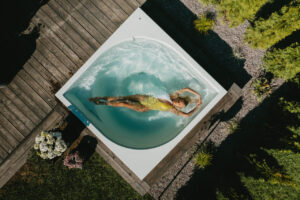Hot tub - an ancient healer
 The first reports of a Japanese bath or furodate back to around the 13th century, when the Japanese were inspired by hot springs and the ancient tradition of relaxing there. Now hot tubs are taking over the world.
The first reports of a Japanese bath or furodate back to around the 13th century, when the Japanese were inspired by hot springs and the ancient tradition of relaxing there. Now hot tubs are taking over the world.
What makes Furo special is that its active ingredient is hot water, not hot air. It is safer and safer for people with joint and muscle problems. The Japanese bath is also a great alternative to natural hot springs, which unfortunately not everyone can enjoy.
But since time immemorial, it has been a tradition in Japan to relax in hot springs and seek health. This tradition gave rise to a business model in Japan centuries ago - holiday homes were built around hot springs, where people could enjoy the pleasures of hot water and rejuvenate their health.
The more exclusive holiday homes were even built over the springs to offer greater comfort and privacy for the more affluent. This tradition is still honoured by the Japanese, and many family holidays are planned around hot springs. It is also almost impossible to travel in Japan without enjoying the pleasures of the hot springs.
Furo - the soul of the community
But people love comfort, and they also wanted to relax at home. The Japanese, not to be distracted by the distance from hot springs, invented the furo - the heated bath.
The Japanese bath is the soul of the community, where both mind and body can be rejuvenated with a good time. Traditionally, the water in a Japanese bath is between 40 and 42 degrees Celsius, and relaxation in the hot water could last up to 20 minutes. The warmth from the water stays in the body for a long time, and after relaxation you will feel a pleasant rush.
In addition to relaxation, a Japanese bath is good for the blood circulation of the whole body, speeds up the metabolism and removes toxins from the body, making the skin more beautiful. While in the traditional Finnish sauna, toxins are removed by a sometimes breathtaking stench, in the Japanese bath it is the relaxing hot water, which, as mentioned, is safer for the joints and muscles.
By the way, isn't the long life expectancy of the Japanese precisely because of their hot springs culture, with current projections suggesting that half of all Japanese born in 2007 will live to be 107.
Hot tubs - handmade tailoring solutions

Lingalaid hot tubs are handmade Japanese baths in Estonia, where you can choose the size, heater and style. There is a choice of hot tubs for a few or three people or for a large group - the choice is yours!
Depending on the model, the Lingalaiu hot tubs can hold between 1100 and 2000 litres of water, heated either by wood or electric heating.
Hot tub baths can be enjoyed all year round - on summer evenings or crisp winter days. A hot tub combines the pleasant with the beneficial, relaxing muscles, promoting circulation and relieving stress at the same time, and when you add to this the pleasure of company, it's hard to find a more enjoyable pastime than a hot tub.
The hot tub is not for washing, it's for healing, relaxing and enjoying the company. Usually, relaxation in a Japanese bath is preceded by a proper body wash, which is a tribute to both oneself and the other person enjoying the bath, and various salts and minerals may be added to the water to further invigorate the body and mind, depending on the preference of the company.